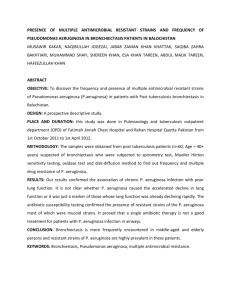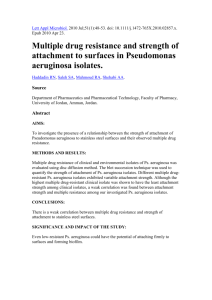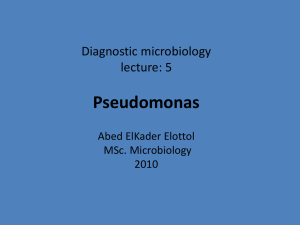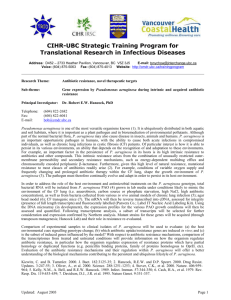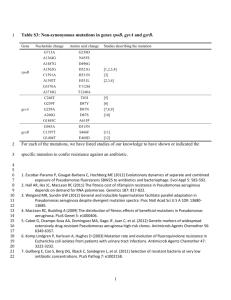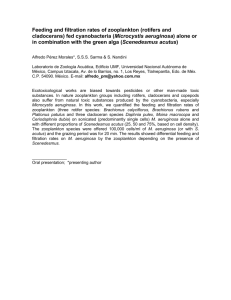Document 13308830
advertisement
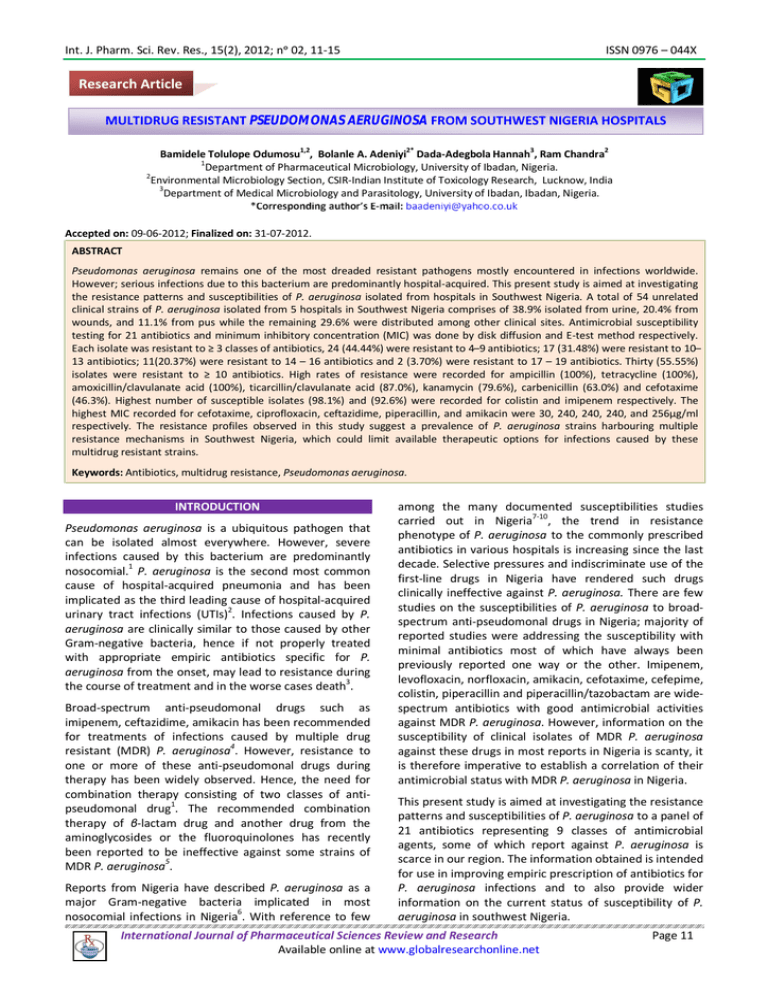
Int. J. Pharm. Sci. Rev. Res., 15(2), 2012; nᵒ 02, 11-15 ISSN 0976 – 044X Research Article MULTIDRUG RESISTANT PSEUDOMONAS AERUGINOSA FROM SOUTHWEST NIGERIA HOSPITALS 1,2 2* 3 2 Bamidele Tolulope Odumosu , Bolanle A. Adeniyi Dada-Adegbola Hannah , Ram Chandra 1 Department of Pharmaceutical Microbiology, University of Ibadan, Nigeria. 2 Environmental Microbiology Section, CSIR-Indian Institute of Toxicology Research, Lucknow, India 3 Department of Medical Microbiology and Parasitology, University of Ibadan, Ibadan, Nigeria. Accepted on: 09-06-2012; Finalized on: 31-07-2012. ABSTRACT Pseudomonas aeruginosa remains one of the most dreaded resistant pathogens mostly encountered in infections worldwide. However; serious infections due to this bacterium are predominantly hospital-acquired. This present study is aimed at investigating the resistance patterns and susceptibilities of P. aeruginosa isolated from hospitals in Southwest Nigeria. A total of 54 unrelated clinical strains of P. aeruginosa isolated from 5 hospitals in Southwest Nigeria comprises of 38.9% isolated from urine, 20.4% from wounds, and 11.1% from pus while the remaining 29.6% were distributed among other clinical sites. Antimicrobial susceptibility testing for 21 antibiotics and minimum inhibitory concentration (MIC) was done by disk diffusion and E-test method respectively. Each isolate was resistant to ≥ 3 classes of antibiotics, 24 (44.44%) were resistant to 4 ̶ 9 antibiotics; 17 (31.48%) were resistant to 10 ̶ 13 antibiotics; 11(20.37%) were resistant to 14 – 16 antibiotics and 2 (3.70%) were resistant to 17 – 19 antibiotics. Thirty (55.55%) isolates were resistant to ≥ 10 antibiotics. High rates of resistance were recorded for ampicillin (100%), tetracycline (100%), amoxicillin/clavulanate acid (100%), ticarcillin/clavulanate acid (87.0%), kanamycin (79.6%), carbenicillin (63.0%) and cefotaxime (46.3%). Highest number of susceptible isolates (98.1%) and (92.6%) were recorded for colistin and imipenem respectively. The highest MIC recorded for cefotaxime, ciprofloxacin, ceftazidime, piperacillin, and amikacin were 30, 240, 240, 240, and 256µg/ml respectively. The resistance profiles observed in this study suggest a prevalence of P. aeruginosa strains harbouring multiple resistance mechanisms in Southwest Nigeria, which could limit available therapeutic options for infections caused by these multidrug resistant strains. Keywords: Antibiotics, multidrug resistance, Pseudomonas aeruginosa. INTRODUCTION Pseudomonas aeruginosa is a ubiquitous pathogen that can be isolated almost everywhere. However, severe infections caused by this bacterium are predominantly nosocomial.1 P. aeruginosa is the second most common cause of hospital-acquired pneumonia and has been implicated as the third leading cause of hospital-acquired urinary tract infections (UTIs)2. Infections caused by P. aeruginosa are clinically similar to those caused by other Gram-negative bacteria, hence if not properly treated with appropriate empiric antibiotics specific for P. aeruginosa from the onset, may lead to resistance during the course of treatment and in the worse cases death3. Broad-spectrum anti-pseudomonal drugs such as imipenem, ceftazidime, amikacin has been recommended for treatments of infections caused by multiple drug resistant (MDR) P. aeruginosa4. However, resistance to one or more of these anti-pseudomonal drugs during therapy has been widely observed. Hence, the need for combination therapy consisting of two classes of antipseudomonal drug1. The recommended combination therapy of β-lactam drug and another drug from the aminoglycosides or the fluoroquinolones has recently been reported to be ineffective against some strains of MDR P. aeruginosa5. Reports from Nigeria have described P. aeruginosa as a major Gram-negative bacteria implicated in most nosocomial infections in Nigeria6. With reference to few among the many documented susceptibilities studies carried out in Nigeria7-10, the trend in resistance phenotype of P. aeruginosa to the commonly prescribed antibiotics in various hospitals is increasing since the last decade. Selective pressures and indiscriminate use of the first-line drugs in Nigeria have rendered such drugs clinically ineffective against P. aeruginosa. There are few studies on the susceptibilities of P. aeruginosa to broadspectrum anti-pseudomonal drugs in Nigeria; majority of reported studies were addressing the susceptibility with minimal antibiotics most of which have always been previously reported one way or the other. Imipenem, levofloxacin, norfloxacin, amikacin, cefotaxime, cefepime, colistin, piperacillin and piperacillin/tazobactam are widespectrum antibiotics with good antimicrobial activities against MDR P. aeruginosa. However, information on the susceptibility of clinical isolates of MDR P. aeruginosa against these drugs in most reports in Nigeria is scanty, it is therefore imperative to establish a correlation of their antimicrobial status with MDR P. aeruginosa in Nigeria. This present study is aimed at investigating the resistance patterns and susceptibilities of P. aeruginosa to a panel of 21 antibiotics representing 9 classes of antimicrobial agents, some of which report against P. aeruginosa is scarce in our region. The information obtained is intended for use in improving empiric prescription of antibiotics for P. aeruginosa infections and to also provide wider information on the current status of susceptibility of P. aeruginosa in southwest Nigeria. International Journal of Pharmaceutical Sciences Review and Research Available online at www.globalresearchonline.net Page 11 Int. J. Pharm. Sci. Rev. Res., 15(2), 2012; nᵒ 02, 11-15 MATERIALS AND METHODS ISSN 0976 – 044X The term “resistance” in this study includes organisms that show intermediate resistance and those that are resistant according to CLSI guideline. Sample collection Fifty-four clinical strains of P. aeruginosa were recovered from different specimens including urine, pus, wound swab, ear swab, blood and high vagina swab of infected patients from 5 different hospitals in 3 Southwest states of Nigeria from March through September 2010. Isolation and identification All isolates recovered were Gram stained and subcultured on Pseudomonas isolation agar base, Hifluoro Pseudomonas Hiveg agar base and Cetrimide agar (Himedia, India) to obtain a pure culture. P. aeruginosa isolates were confirmed by standard biochemical methods as described previously11. Antimicrobial susceptibility testing Antimicrobial susceptibility testing of 54 isolates of P. aeruginosa against 21 antibiotics (Oxoid, UK) (Table 2), representing 9 classes of antimicrobial agents was performed by the Kirby Bauer disc diffusion method and interpreted according to the Clinical and Laboratory Standards Institute guidelines12. Twenty clinical strains of P. aeruginosa among those that shows resistance ≥ 3classes of antibiotics were randomly selected for the minimum inhibitory concentration (MIC) determination. MIC of antibiotics was determined by E-Test Strip from Himedia Laboratories Pvt. Ltd., Mumbai India. Inoculated plates were incubated aerobically at 37oC and estimated after 18hrs. For quality control of the experiment P. aeruginosa ATCC 27853 and E.coli ATCC 25922 were used. Table 1: Distribution of P. aeruginosa recovered from various clinical specimens Source/site Urine Wound swab Pus Blood Ear swab HVS Throat swab Trachea aspirate Leg ulcer Total No of isolates 21 11 6 3 5 2 3 2 1 54 Percentage (%) 38.9 20.4 11.1 5.5 9.3 3.7 5.6 3.7 1.8 100.0 RESULTS Prevalence of Pseudomonas aeruginosa in clinical specimens The susceptibility patterns and resistance profiles of the 54 clinical isolates of P. aeruginosa by disk diffusion method to a panel of 21 antibiotics was investigated. Table 1 shows the distribution of P. aeruginosa recovered from various clinical specimens. The predominant isolates recovered were from urine (38.9%), wound (20.4%) and pus (11.1%) while few isolates were recovered from ear swab (9.3%), blood (5.5%), HVS (3.7%), throat swab (5.6%), trachea aspirate (3.7%) and from leg ulcer (1.8%). Table 2: The susceptibility patterns of 54 Pseudomonas aeruginosa strains and the percentage (%) resistance to 21 antibiotics Antibiotic (Disc potency, µg) Amikacin (30) Amoxicillin/clavulanic acid (20/10) Ampicillin (25) Aztreonam (30) Carbenicillin (100) Cefepime (30) Cefotaxime (30) Ceftazidime (30) Ceftriaxone (30) Ciprofloxacin (5) Colistin (10) Gentamicin (10) Imipenem (10) Kanamycin (30) Levofloxacin (5) Norfloxacin (10) Piperacillin (100) Piperacillin-tazobactam (100 /10) Streptomycin (10) Tetracycline (30) Ticarcillin/clavulanic (75/10) No. and (%) Sensitive 42 (77.8) 0(0) 0 (0) 30 (55.6) 20 (37.0) 44 (81.4) 26 (48.1) 45 (83.30 25 (46.3) 35 (64.8) 53 (98.1) 32 (59.3) 50 (92.6) 11 (20.4) 33 (61.1) 33 (61.1) 33 (61.1) 33 (61.1) 32 (59.3) 0 (0) 47 (87.0) No. and (%) Intermediate 2 (3.7) NA NA 6 (11.1) 5 (9.3) 5 (9.3) 3 (5.6) 1 (1.9) 14 (25.9) 4 (7.4) NA NA 3 (5.5) NA 1 (1.9) 3 (5.6) NA NA NA NA NA International Journal of Pharmaceutical Sciences Review and Research Available online at www.globalresearchonline.net No. and (%) Resistant 10 ( 18.5) 54 (100) 54 (100) 18 (33.3) 29 (53.7) 5 (9.3) 25 ( 46.3) 8 (14.8) 15 (27.8) 15 (27.8) 1 (1.9) 22 (40.7) 1 (1.9) 43 (79.6) 20 (37.0) 18 (33.3) 21 (38.9) 21 (38.9) 22 (40.7) 54 (100) 7 (13.0) Page 12 Int. J. Pharm. Sci. Rev. Res., 15(2), 2012; nᵒ 02, 11-15 ISSN 0976 – 044X Table 3: MICs of different antibiotics for clinical P. aeruginosa isolates by E-Test Strain No 1 5 8 12 16 17 24 25 27 28 32 34 38 40 42 45 46 48 49 52 PIP 240.0 240.0 60.0 5.0 5.0 30.0 120.0 120.0 1.0 1.0 5.0 240.0 5.0 240.0 240.0 240.0 1.0 120.0 240.0 1.0 CAZ 240.0 240.0 15.0 7.5 15.0 30.0 120.0 5.0 3.0 1.0 15.0 240.0 1.0 120.0 15.0 120.0 7.5 30.0 15.0 7.5 Concentrations are in µg/ml Antibiotics CTX CRO CIP LEV 15.0 240.0 0.01 0.01 15.0 240.0 0.25 1.0 7.5 240.0 1.0 2.0 3.0 3.0 0.001 0.01 3.0 7.5 0.01 0.25 15.0 240.0 0.004 0.25 15.0 240.0 0.5 0.5 15.0 240.0 1.0 1.0 3.0 7.5 30.0 0.005 3.0 15.0 0.008 0.005 15.0 240 240.0 240.0 15.0 240.0 240.0 240.0 3.0 240.0 240.0 240.0 15.0 240.0 240.0 240.0 30.0 240.0 0.01 0.25 7.5 240.0 240.0 240.0 1.0 15.0 0.01 0.05 15.0 240.0 240.0 240.0 15.0 240.0 2.0 2.0 3.0 7.5 0.008 0.05 AK 2.0 4.0 0.5 0.1 0.1 0.5 256.0 256.0 0.05 0.05 256.0 256.0 256.0 256.0 0.05 256.0 2.0 256 0.1 0.05 GEN 256.0 256.0 256.0 0.5 0.1 256.0 256.0 256.0 0.1 0.1 256.0 256.0 256.0 256.0. 0.5 256.0 4.0 256.0 0.1 0.05 PIP; piperacillin, CAZ; ceftazidime, CTX; cefotaxime, CRO; ceftriaxone, CIP; ciprofloxacin, Lev; levofloxacin, AK; amikacin, GEN; gentamicin Antimicrobial susceptibility and determination of MICs The rates of resistance were highest for ampicillin (100%), amoxicillin/clavulanic acid (100%), tetracycline (100%), ticarcillin/clavulanic acid (87.0%), kanamycin (79.6%) and carbenicillin (63.0%). High susceptibility of most of the isolates was recorded for colistin (98.1%) and imipenem (92.6%). Each isolate was resistant to ≥ 3 classes of antibiotics, 24 (44.44%) were resistant to 4 ̶ 9 antibiotics; 17 (31.48%) were resistant to 10 ̶ 13 antibiotics; 11 (20.37%) were resistant to 14 – 16 antibiotics and 2 (3.70%) were resistant to 17 – 19 antibiotics. Thirty (55.55%) isolates were resistant to ≥ 10 antibiotics (table 2). Table 3 depicts the MIC values for the 20 randomly selected P. aeruginosa strains in this study. MIC range obtained in this study for cefotaxime was 1-30 µg/ml, ceftazidime 0.25-240 µg/ml, ceftriaxone 7.5-240 µg/ml, piperacillin 1-240 µg/ml, ciprofloxacin 0.001-240 µg/ml, levofloxacin 0.005-240 µg/ml and amikacin 0.1-256 µg/ml. DISCUSSION This present study investigated the susceptibility of 54 P. aeruginosa to 21 antimicrobial agents some of which are newer drugs belonging to β–lactam, fluoroquinolones and aminoglycosides classes of antibiotics that have been shown by many studies to be active against MDR bacteria including P. aeruginosa. The highest number of susceptibility of P. aeruginosa isolates was recorded for colistin (98.1%) followed by imipenem (92.6%). Our result for colistin contradicts studies from Nwankwo and Shuaibu13 who reported 78.9% susceptibility of P. aeruginosa but corroborate result of Aibinu et al14 and Olayinka et al15 who reported 95.6% and 94.6% susceptibility to imipenem respectively. This implies that imipenem remain a potent anti-pseudomonal antimicrobial agent in Nigeria contrary to other report outside Nigeria where imipenem resistance is prevalent16. All the P. aeruginosa (100%) investigated in this study were resistant to amoxicillin/clavulanic, ampicillin and tetracycline. This observed resistance pattern has been a frequent report about P. aeruginosa in many susceptibility studies in Nigeria. In clinical context, we suggest a total replacement of these drugs as a therapeutic option in the management of P. aeruginosa infections in Nigeria. Meanwhile, we observed a decrease in fluoroquinolones susceptibilities among our isolates as compared to earlier studies in Nigeria. Fluoroquinolones (FQ) susceptibilities in this study are as follows; Ciprofloxacin (64.8%), levofloxacin (63.0%) and norfloxacin (66.7%). This is lower than 72.0-100% susceptibilities ciprofloxacin reported by many authors (Okonko et al.17 Jombo et al.18 Olayinka et al.15 ElMahmood et al.19 and Ogbolu et al.20). High resistance to FQ as observed in our study has also been similarly 14 reported elsewhere. However, higher resistance (98%) 21 to ciprofloxacin was obtained in India . The findings from our result also agree with the previous publication on emerging fluoroquinolone resistance P. aeruginosa in 22 Nigeria . The steady increment in FQ resistance in this study is alarming and the implication might be as a loss of confidence in the use of FQ alone in the management of Pseudomonas infection considering the fact that FQ are International Journal of Pharmaceutical Sciences Review and Research Available online at www.globalresearchonline.net Page 13 Int. J. Pharm. Sci. Rev. Res., 15(2), 2012; nᵒ 02, 11-15 potent antimicrobial agent with broad-spectrum activities that has gained a wide use in management of many infections. Increasing resistance to this broad-spectrum antibiotic might be as a result of selective pressure due to its frequent use in Nigeria. We recommend they should henceforth be used with caution and mostly in combination with broad-spectrum betalactams/penicillins in order to prevent total loss of activities. The result of this study reveals an increasing trend of resistance to the cephalosporins investigated. Among the third-generation cephalosporin, ceftriaxone was found to be least active as 46.3% isolates were susceptible, followed closely by cefotaxime (48.1%). Previous report in Nigeria8, 9, 23 have also obtained low susceptibilities in their studies with ceftriaxone and cefotaxime. Ceftazidime was most active as 83.30% of the isolates 14 were susceptible to it. Aibinu et al also reported a close value of 79.4% of this drug against P. aeruginosa in their study. Although a contrary report or rather decrease in activity was observed for ceftazidime as compared to 13, 24 previous reports where over 90% of susceptibilities to ceftazidime were reported for P. aeruginosa. This result also agrees with other study in India21 where less resistance were shown to this antibiotic by P. aeruginosa. A high level of resistance (MIC ≥ 240µg) was observed in 15% and 70% of the resistant strains tested in this study against ceftazidime and ceftriaxone respectively. This means that these strains are speedily acquiring resistance against third-generation cephalosporins, unless it is henceforth used in combination with an aminoglycosides or fluoroquinolones that are resistant to extendedspectrum beta-lactamase, resistance to cephalosporin will be imminent. An interesting finding in this study is the emerging resistance to cefepime. Cefepime is a fourthgeneration cephalosporin, one of the few remaining agents that have a reliable activity against P. aeruginosa25. However, resistance observed against cefepime (18.4%) in this study is troubling, considering the fact that its use in Nigeria is rarely reported. Prompt attention is hereby imperative to check this emergence in order to prevent the complications in the treatments of P. aeruginosa. Cephalosporins are beta-lactams antibiotics with reported desired effect and lesser toxicity. Increase in their resistance by P. aeruginosa could be attributed to the increase in extended-spectrum beta-lactamase (ESBL) production among the strains of P. aeruginosa, which has also been previously reported14. Out of the three β-lactamase inhibitors considered in this study, we observed that piperacillin/tazobactam inhibitory activity was the highest (61.1%) compared to ticarcillin/clavulanate (13.0%) and amoxicillin/clavulanate (0%). This result also supports the view that tazobactam inhibitory activity against ESBL is almost 10-fold greater 26 than clavulanic acid . This suggests piperacillin/ tazobactam is preferably active against P. aeruginosa among the other beta-lactamase inhibitors in this study. ISSN 0976 – 044X High resistance to penicillins was also observed in this study carbenicillin (53.7%), piperacillin (38.9%). Of a note is also a high resistance to Aztreonam as 44.4% of the 14 isolates showed resistance to the drug. Earlier studies has reported 36.1% resistance to Aztreonam by P. aeruginosa that were also reported to be ESBL producers. Aztreonam is an Oxyimino-monobactam recommended as anti-pseudomonal drug and hasn’t been widely prescribed in Nigeria. These observations clearly indicate the prevalence of ESBL among the resistant strains in this study. Susceptibility pattern among the aminoglycosides is as follows; amikacin (77.8%), gentamicin (59.3%), streptomycin (59.3%) and kanamycin (20.4%). Our result is contrary to studies by Okesola and Oni9 who reported 66.7% susceptibility in gentamicin and 100% resistance in streptomycin, and also contradicts Iwalokun et al 27 who reported susceptibilities as follows; gentamicin (66.7%), streptomycin (53.3%) and Nwankwo and Shuaibu13 who reported gentamicin (50%), streptomycin (43.7%). However, the susceptibility of P. aeruginosa to amikacin 20 in this study is consistent with Ogbolu et al . who reported 78.3% susceptibility to amikacin, Iwaloku et al.27 reported (73.3%), Olayinka et al15 (2009) reported (89.1%) and also correlated with studies from Aibinu et al.14 who reported 78.4% susceptibility to amikacin indicating low resistance profile status for P. aeruginosa to amikacin in Nigeria. The MIC values for the selected amikacin and gentamicin resistant strains in this study were significantly high as 40% and 60% of the strains had MIC value (≥256µg/ml) for amikacin and gentamicin respectively. Our result corroborate previous reports where high MIC values were obtained among P. aeruginosa strains against aminoglycosides.28, 29 From the result of this study it could be suggested that the first-line aminoglycoside such as gentamicin; streptomycin and kanamycin for which resistance has become persistent to be replaced or restricted. Common uses of these antibiotics have reduced their therapeutic relevancy, hence the use of amikacin should be considered more to prevent further resistance. CONCLUSION In conclusion, this study has shown multiple drug resistant P. aeruginosa at a high prevalence among the southwest hospitals investigated in Nigeria. High resistance of P. aeruginosa to multiple classes of antibiotics especially to recent generation of cephalosporin (cefepime) and oxyimino-monobactam (Aztreonam) is a disturbing clinical problem especially in our country where the cost of affordable antibiotics is a bit high. One of the major implications of persistent resistance of P. aeruginosa is the increase in the cost of its treatment due to high cost of purchasing antipseudomonal drugs such as imipenem, which appears to be very active in this study. However, the findings of this study underscore the need for the establishment of a functional antimicrobial surveillance system for P. International Journal of Pharmaceutical Sciences Review and Research Available online at www.globalresearchonline.net Page 14 Int. J. Pharm. Sci. Rev. Res., 15(2), 2012; nᵒ 02, 11-15 aeruginosa to oversee the trend of resistance to prescribed antibiotics in our environment. This will also guide clinicians in the appropriate therapy and management of Pseudomonas infections. We believe this move will also reduce the propensity of development of resistance in the course of treatment; and possibly curb the high rates of multiple drug resistance. The government may do well to enact laws to prohibit indiscriminate use and prescription of antibiotics and improve on public enlightenment programs to stop drug abuse. Acknowledgement: This work was supported by The World Academy of Science (TWAS) and Council of Scientific and Industrial Research India (CSIR) Postgraduate Fellowship Award. REFERENCES 1. Mesaros N, Nordmann P, Plésiat P, Roussel-Delvallez M, Van Eldere J and Glupczynski Y et al. Pseudomonas aeruginosa: resistance and therapeutic options at the turn of the new millennium. Clin Microbiol Infect. 13, 2007, 560-578. 2. Mahesh E, Ramesh D, Indumathi VA, Punith K, Kirthi R and Anupama H. Complicated urinary tract infection in a Tertiary Care Center in South India. Al Ameen J Med Sci. 3, 2010, 120-127. 3. Micek ST, Lloyd AE, Ritchie DJ, Reichley RM, Fraser VJ and Kollef MH. Pseudomonas aeruginosa bloodstream infection: importance of appropriate initial antimicrobial treatment. Antimicrob Agents Chemother. 49, 2005, 1306-1311. 4. Oie SS, Kamiya A and Mizuno H. In-vitro effects of a combination of antipseudomonal antibiotics against multi-drug resistant Pseudomonas aeruginosa. J Antimicrob Chemother. 44, 1999, 689691. 5. Page MG and Heim J. Prospects for the next anti-Pseudomonas drug. Curr Opin Pharmacol. 9, 2009, 558-565. 6. Ohieku JD, Nnolim M.I and Galadima G.B. Bacteraemia among inpatient of University of Maiduguri Teaching Hospital: The pathogens involved their susceptibilities to antibacterial agents and multi-drugs resistant patterns. J Medi Appl Biosci. 2, 2010, 1-8. 7. Chah KF, Ezeh CA and Oluoha BN. Frequency and antimicrobial resistance of aerobic bacteria isolated from surgical sites in humans and animals in Nsukka, Southeast Nigeria. Nig Vet J. 24, 2003,1-9. 8. Brown BJ. Asinobi AO, Fatunde OJ, Osinusi K, and Fashina NA. Antimicrobial sensitivity pattern of organisms causing urinary tract infection in children with sickle cell anaemia in Ibadan, Nigeria. WAJM 22, 2003, 110-113. 9. Okesola AO and Oni AA. Antimicrobial resistance among common bacterial pathogens in South Western Nigeria. Amer-Eura J Agric Environ Sci. 5, 2009, 327-330. 10. Oluremi BB, Idowu AO. and Olaniyi JF. Antibiotic susceptibility of common bacterial pathogens in urinary tract infections in a Teaching hospital in Southwestern Nigeria. Afr J Microbio Res. 5, 2011, 3658-3663. 11. Cheesbrough M. District laboratory practice in tropical countries Part 2, Cambridge University Press. 2000 12. CLSI. Performance Standards for Antimicrobial Susceptibility Testing; Twentieth Informational Supplement. 2010: CLSI Document M100S20, Wayne, PA: Clinical and Laboratory Standard Institute. 13. Nwankwo EOK, Shuaibu S.A. Antibiotic susceptibility pattern of clinical isolates of Pseudomonas aeruginosa in a tertiary health institution in Kano, Nig J of Med Biomed Sc. 2010, 37-40 ISSN 0976 – 044X 14. Aibinu I, Nwanneka T and Odugbemi T. Occurrence of ESBL and MBL in Clinical Isolates of Pseudomonas aeruginosa From Lagos, Nig J Ame Sc. 3, 2007, 81-85 15. Olayinka AT, Olayinka BO and Onile BA. Antibiotic susceptibility and plasmid pattern of Pseudomonas aeruginosa from the surgical unit of a university teaching hospital in north central Nigeria. Int J Med Med Sci. 3, 2009, 079-083. 16. Otaibi FEA and Hulaily FFA Imipenem-resistant Psedomonas aeruginosa: Epidemiology and susceptibility patterns at a Teaching Hospital in Riyadh, Saudi Arabia Afr JMicrobio Res. 6, 2012, 15271533. 17. Okonko IO, Adebiyi SF, Amusan TA, Ogun AA, Ogunnusi TA. and Ejembi J Incidence of Multi-Drug Resistance (MDR) Organisms in Abeokuta, Southwestern Nigeria Global Journal of Pharmacology, 3, 2009, 69-80. 18. Jombo GTA., Jonah P and Ayeni JA. Multidrug resistant Pseudomonas aeruginosa in contemporary medical practice: findings from urinary isolates at a Nigerian University Teaching Hospital. Nigerian Journal of Physiological Sciences 23, 2008, 105109. 19. El-Mahmood AM, Atimi AT, Tirmidhi AB. and Mohammed A. Antimicrobial susceptibility of some quinolone antibiotics against some urinary tract pathogens in a tertiary hospital, Yola, adamawa State, Nigeria. J Clin Med Res 1, 2009, 026-034. 20. Ogbolu DO, Ogunledun A, Adebiyi OE, Daini OA, Alli AO and Terry AO. Antibiotic susceptibility patterns of Pseudomonas aeruginosa to available antipseudomonal drugs in Ibadan, Nigeria. Afr J Med Med Sci. 37, 2008, 339-44. 21. Ravichandra HP, Belodu R, Karangate N, Sonth S and Vijayanath A. Antimicrobial susceptibility pattern of Pseudomonas aeruginosa strains isolated from clinical sources. J Pharm Bio Sc. 14, 2012, 1-5. 22. Lamikanra A, Crowe JL, Lijek RS, Odetoyin BW, Wain J, Aboderin A and Okeke IN. Rapid evolution of fluoroquinolone-resistant Escherichia coli in Nigeria is temporally associated with fluoroquinolone use. BMC Infect Dis.11, 2011, 312-2334. 23. Nwachukwu NC, Orji FA and Okike UM. Antibiotic Susceptibility Patterns of Bacterial Isolates from Surgical Wounds in Abia State University Teaching Hospital (ABSUTH), Aba – Nigeria Res J Med Med Sc. 4, 2009, 575-579. 24. Oni AA, Nwaorgu OGB, Bakare RA, Ogunkunle MO and Toki RA. The discharging ears in Adults in Ibadan, Nigeria causative agents and antimicrobial sensitivity pattern. Af. J. Clin. Exp. Microbiol. 3, 2002, 3-5. 25. Akhabue E, Synnestvedt M, Weiner MG, Bilker WB and Lautenbach E. Cefepime-Resistant Pseudomonas aeruginosa Emerg Infect Dis. 17, 2011, 1037-1043 26. Bush K, Macalintal C, Rasmussen BA, Lee VJ and Yang Y. Kinetic interaction of tazobactam with beta-lactamases from all major structural classes. Antimicrob Agents Chemother. 37, 1993, 851858. 27. Iwalokun BA, Oluwadun A, Akinsinde KA, Niemogha MT and Nwaokorie FO. Bacteriologic and plasmid analysis of etiologic agents of conjunctivitis in Lagos, Nigeria J Ophthal Inflamm Infect. 1, 2011, 95–103. 28. Shahid M and Malik A. Plasmid mediated amikacin resistance in clinical isolates of Pseudomonas aeruginosa. Indian J Med Microbiol. 22, 2004, 182-184. 29. Kim JY Park, YJ Kwon HJ Han K, Kang MW and Woo GJ. Occurrence and mechanisms of amikacin resistance and its association with beta-lactamases in Pseudomonas aeruginosa: a Korean nationwide study. J Antimicrob Chemother. 62, 2008, 479-83. ********************* International Journal of Pharmaceutical Sciences Review and Research Available online at www.globalresearchonline.net Page 15
